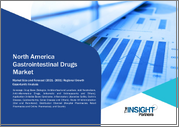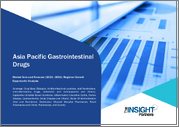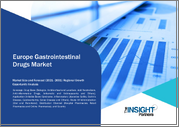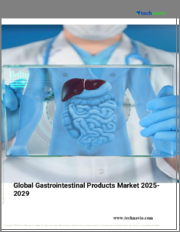
|
시장보고서
상품코드
1782116
소화관 치료제 시장 : 시장 기회, 성장 촉진요인, 산업 동향 분석, 예측(2025-2034년)Gastrointestinal Therapeutics Market Opportunity, Growth Drivers, Industry Trend Analysis, and Forecast 2025 - 2034 |
||||||
세계의 소화관 치료제 시장 규모는 2024년에 425억 달러로 평가되었고, CAGR 5.9%로 성장할 전망이며, 2034년에는 748억 달러에 이를 것으로 추정됩니다.
이 시장 확대는 염증성 장 질환(IBD), 위식도 역류증(GERD), 소화성 궤양 질환 등 위장(GI) 질환의 유병률 상승이 주요 요인입니다. 성인 인구가 증가함에 따라 만성 소화기 질환의 이환율도 증가하는 경향이 있으며 환자 수가 증가하고 전문 치료에 대한 수요가 증가하고 있습니다. 치료되지 않은 소화기 질환은 특히 궤양성 대장염과 같은 경우 대장암이나 중독성 거대 결장과 같은 심각한 합병증을 유발할 수 있습니다. 이러한 추세는 효과적이고 장기적인 치료의 필요성을 부각시키고 생물학적 제제 및 표적 치료제와 같은 고급 치료 옵션에 대한 수요에 박차를 가하고 있습니다.
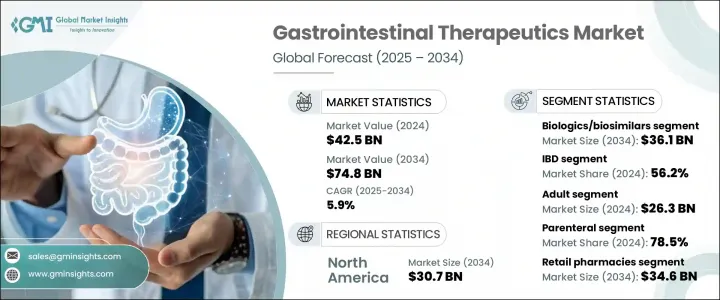
생물학적 제형과 바이오시밀러의 개발은 시장 성장을 가속화하는 데 중요한 역할을 합니다. 이러한 치료는 염증을 조절하고 장기적인 관해를 유지하는 표적 치료를 제공함으로써 소화기 질환의 관리에 매우 효과적인 것으로 입증되었습니다. 연구개발(R&D)에 대한 투자가 증가하고 규제당국의 승인을 꾸준히 얻을 수 있게 된 것이 이 분야의 기술 혁신을 뒷받침하고 있습니다. 게다가 소화기 질환에 대한 일반 시민의 의식 향상, 진단 도구의 진보, 신흥국에서의 헬스케어 액세스의 확대에 의해 이러한 치료가 보다 많은 사람들에게 제공되게 되어, 시장의 성장을 더욱 추진하고 있습니다.
| 시장 범위 | |
|---|---|
| 시작 연도 | 2024년 |
| 예측 연도 | 2025-2034년 |
| 시작 금액 | 425억 달러 |
| 예측 금액 | 748억 달러 |
| CAGR | 5.9% |
생물제제 및 바이오시밀러 의약품 분야는 2024년에 196억 달러로 평가되었고, 2034년에는 361억 달러에 이를 전망이며, CAGR 6.4%로 성장할 것으로 예측됩니다. 이 치료는 크론 병과 궤양성 대장염과 같은 질병을 관리하기 위해 선호되는 옵션입니다. 생물학적 제제는 염증 컨트롤에 과녁을 맞춘 어프로치를 제공하는 한편, 바이오시밀러는 치료비를 인하하는 것으로 이러한 치료법에 대한 액세스를 향상시켜 전세계의 환자에게 보다 저렴한 가격이 되고 있습니다. 주요 약제의 바이오시밀러가 최근 승인된 것은 선진 치료에 대한 접근성 확대에 더욱 기여하고 있습니다.
2024년 성인 부문은 263억 달러를 창출하였고, 2034년까지 연평균 복합 성장률(CAGR) 5.6%로 성장하여 지배적인 지위를 유지할 것으로 예측되고 있습니다. 성인 인구는 크론병, 궤양성 대장염, GERD, 기타 관련 질환과 같은 만성 소화관(GI) 질환에 특히 이환되기 쉽습니다. 이러한 유병률의 증가는 식생활의 혼란, 높은 스트레스 수준, 앉아 있는 습관과 같은 현대적인 라이프 스타일 요인에 의한 것이 크며, 이들 모두가 장기적인 의료를 필요로 하는 GI 질환의 증가에 기여하고 있습니다. 증대하는 수요에 대응하기 위해서, 제약 기업은, 치료 효과의 향상과 환자의 컴플리언스 강화를 목표로 해 주사제나 서방성 정제 등, 표적을 좁힌 약제 제제나 약물 전달의 개발을 진행시키고 있습니다.
북미의 소화관 치료제 2024년 시장 규모는 178억 달러로 평가되었고, 2034년에는 307억 달러에 이를 전망이며, CAGR 5.6%를 보일 것으로 예측되고 있습니다. 북미의 시장 지위가 높은 것은 고도의 헬스케어 인프라, 소화기계 건강에 대한 높은 의식, 최신 치료 옵션에 대한 접근의 보급에 기인합니다. 주요 제약기업의 존재와 지속적인 기술 혁신 및 연구 노력이 계속 시장을 견인하고 있습니다. 생명공학 기업과 연구기관의 협력관계는 신규 치료법의 개발과 이용을 더욱 가속화시켜 북미가 세계 소화관 치료제 시장의 주요 기업으로 계속 남을 것임을 확실히 하고 있습니다.
세계의 소화관 치료제 시장에 진입하는 주목할 만한 기업은 Takeda Pharmaceutical, GlaxoSmithKline, Eli Lilly and Company, Johnson & Johnson, Cipla, AstraZeneca, Biogen, Pfizer, Bayer, Sanofi, Sun Pharma, AbbVie, Phathom Pharmac Reddy's Laboratories 등이 있습니다. 소화관 치료제 시장의 주요 기업은 생물 제제 및 바이오시밀러의 혁신을 통해 제품 포트폴리오를 확대하는 데 주력하고 있습니다. 많은 기업들은 소화기 질환의 근본적인 원인에 대처하는 보다 효과적인 치료법을 개발하기 위해 최첨단 연구에 투자하고 있습니다. 연구기관 및 바이오테크놀로지 기업과의 제휴도 의약품 개발과 상업화를 가속화하기 위한 일반적인 전략입니다. 또한 기업은 치료를 보다 친근하고 저렴한 것으로 함으로써 특히 신흥 시장에서의 지리적 확대를 우선시하고 있습니다.
목차
제1장 조사 방법 및 범위
제2장 주요 요약
제3장 업계 인사이트
- 생태계 분석
- 공급자의 상황
- 각 단계에서의 부가가치
- 밸류체인에 영향을 주는 요인
- 업계에 미치는 영향요인
- 성장 촉진요인
- 소화기 질환의 유병률 상승
- 의약품 개발의 진보
- 위장 건강에 관한 의식 향상 및 예방 케어 대책
- 연구개발 투자 및 활동 증가
- 업계의 잠재적 위험 및 과제
- 약의 부작용
- 시장 기회
- 장내 세균총 조사에 대한 관심의 고조
- 디지털 헬스 플랫폼은 소화기계 치료에 대한 액세스 개선
- 성장 촉진요인
- 성장 가능성 분석
- 파이프라인 분석
- 규제 상황
- 장래 시장 동향
- Porter's Five Forces 분석
- PESTEL 분석
제4장 경쟁 구도
- 서문
- 기업 매트릭스 분석
- 기업의 시장 점유율 분석
- 주요 시장 기업의 경쟁 분석
- 경쟁 포지셔닝 매트릭스
- 주요 발전
- 합병 및 인수
- 파트너십 및 협업
- 확장 계획
제5장 시장 추계 및 예측 : 약제 유형별(2021-2034년)
- 주요 동향
- 설사 방지
- 완하제
- 생물제제 및 바이오시밀러
- 제토제
- 항궤양제
- 항생제
- 제산제
- 양성자 펌프 억제제(PPI)
- 기타 약물의 유형
제6장 시장 추계 및 예측 : 병 유형별(2021-2034년)
- 주요 동향
- 염증성 장질환(IBD)
- 크론병
- 궤양성 대장염
- 위식도 역류증(GERD)
- 스테이지 1
- 스테이지 2
- 스테이지 3
- 스테이지 4
- 소화성 궤양
- 과민성 장 증후군(IBS)
- 과민성 장 증후군(IBS)
- 과민성 장 증후군(IBS-C)
- 과민성 장 증후군(IBS) M형
- 기타 질병의 유형
제7장 시장 추계 및 예측 : 약 유형별(2021-2034년)
- 주요 동향
- 브랜드
- 제네릭 의약품
제8장 시장 추계 및 예측 : 연령별(2021-2034년)
- 주요 동향
- 소아
- 성인
- 고령자
제9장 시장 추계 및 예측 : 투여 경로별(2021-2034년)
- 주요 동향
- 경구
- 비경구
제10장 시장 추계 및 예측 : 유통 채널별(2021-2034년)
- 주요 동향
- 병원 약국
- 소매 약국
- 온라인 약국
제11장 시장 추계 및 예측 : 지역별(2021-2034년)
- 주요 동향
- 북미
- 미국
- 캐나다
- 유럽
- 독일
- 영국
- 프랑스
- 스페인
- 이탈리아
- 네덜란드
- 아시아태평양
- 중국
- 일본
- 인도
- 호주
- 한국
- 라틴아메리카
- 브라질
- 멕시코
- 아르헨티나
- 중동 및 아프리카
- 남아프리카
- 사우디아라비아
- 아랍에미리트(UAE)
제12장 기업 프로파일
- AbbVie
- AstraZeneca
- Bayer
- Biogen
- Cipla
- Dr. Reddy's Laboratories
- Eli Lilly and Company
- GlaxoSmithKline
- Glenmark Pharmaceuticals
- Johnson &Johnson
- Novo Nordisk
- Pfizer
- Phathom Pharmaceuticals
- Sanofi
- Sun Pharma
- Takeda Pharmaceutical
The Global Gastrointestinal Therapeutics Market was valued at USD 42.5 billion in 2024 and is estimated to grow at a CAGR of 5.9% to reach USD 74.8 billion by 2034. This market expansion is largely driven by the rising prevalence of gastrointestinal (GI) disorders, such as inflammatory bowel disease (IBD), gastroesophageal reflux disease (GERD), and peptic ulcer disease. As the adult population continues to expand, the incidence of chronic GI conditions is also on the rise, creating a larger patient base and increasing demand for specialized treatments. Untreated GI conditions can lead to severe complications, including colorectal cancer and toxic megacolon, particularly in cases like ulcerative colitis. These trends highlight the need for effective, long-term therapies, fueling the demand for advanced treatment options such as biologics and targeted therapies.

The development of biologics and biosimilars has played a critical role in accelerating market growth. These therapies have proven to be highly effective in managing GI disorders by providing targeted treatments that control inflammation and help maintain long-term remission. Increased investment in research and development (R&D), along with a steady stream of regulatory approvals, has driven innovation in the field. Additionally, improved public awareness of GI health, advancements in diagnostic tools, and the expansion of healthcare access in emerging economies have made these treatments more available to a broader population, further supporting market growth.
| Market Scope | |
|---|---|
| Start Year | 2024 |
| Forecast Year | 2025-2034 |
| Start Value | $42.5 Billion |
| Forecast Value | $74.8 Billion |
| CAGR | 5.9% |
The biologics and biosimilars segment was valued at USD 19.6 billion in 2024 and is expected to reach USD 36.1 billion by 2034, growing at a CAGR of 6.4%. These treatments have become the preferred option for managing conditions like Crohn's disease and ulcerative colitis. Biologics offer a targeted approach to inflammation control, while biosimilars have increased access to these therapies by lowering the cost of treatment, making them more affordable for patients worldwide. The recent approval of biosimilars for key drugs has further contributed to the growing accessibility of advanced treatments.
In 2024, the adult segment generated USD 26.3 billion and is projected to maintain its dominant position, growing at a CAGR of 5.6% through 2034. The adult population is especially vulnerable to chronic gastrointestinal (GI) conditions like Crohn's disease, ulcerative colitis, GERD, and other related disorders. This increased prevalence is largely driven by modern lifestyle factors, such as poor dietary choices, high stress levels, and sedentary habits, all of which contribute to a rise in GI issues that require long-term medical care. To meet the growing demand, pharmaceutical companies are advancing the development of targeted drug formulations and delivery methods, including injectables and sustained-release tablets, aimed at improving treatment efficacy and enhancing patient compliance.
North America Gastrointestinal Therapeutics Market generated USD 17.8 billion in 2024 and is expected to generate USD 30.7 billion by 2034, growing at a CAGR of 5.6%. North America's strong market position is attributed to its advanced healthcare infrastructure, high awareness of digestive health, and widespread access to modern treatment options. The presence of leading pharmaceutical companies, along with ongoing innovation and research efforts, continues to drive the market. Collaborative partnerships between biotech firms and research institutions further accelerate the development and availability of novel therapies, ensuring that North America remains a key player in the global GI therapeutics market.
Notable companies involved in the Global Gastrointestinal Therapeutics Market include Takeda Pharmaceutical, GlaxoSmithKline, Eli Lilly and Company, Johnson & Johnson, Cipla, AstraZeneca, Biogen, Pfizer, Bayer, Sanofi, Sun Pharma, AbbVie, Phathom Pharmaceuticals, and Dr. Reddy's Laboratories. Leading companies in the gastrointestinal therapeutics market are focusing on expanding their product portfolios through innovation in biologics and biosimilars. Many are investing in cutting-edge research to develop more effective treatments that address the underlying causes of GI disorders. Partnerships with research institutions and biotech firms are also a common strategy to accelerate drug development and commercialization. Additionally, companies are prioritizing geographical expansion, particularly in emerging markets, by making treatments more accessible and affordable.
Table of Contents
Chapter 1 Methodology and Scope
- 1.1 Market scope and definition
- 1.2 Research design
- 1.2.1 Research approach
- 1.2.2 Data collection methods
- 1.3 Data mining sources
- 1.3.1 Global
- 1.3.2 Regional/Country
- 1.4 Base estimates and calculations
- 1.4.1 Base year calculation
- 1.4.2 Key trends for market estimation
- 1.5 Primary research and validation
- 1.5.1 Primary sources
- 1.6 Forecast model
- 1.7 Research assumptions and limitations
Chapter 2 Executive Summary
- 2.1 Industry 3600 synopsis
- 2.2 Key market trends
- 2.2.1 Regional
- 2.2.2 Drug type
- 2.2.3 Disease type
- 2.2.4 Medication type
- 2.2.5 Age group
- 2.2.6 Route of administration
- 2.2.7 Distribution channel
- 2.3 CXO perspectives: Strategic imperatives
- 2.3.1 Key decision points for industry executives
- 2.3.2 Critical success factors for market players
- 2.4 Future outlook and strategic recommendations
Chapter 3 Industry Insights
- 3.1 Industry ecosystem analysis
- 3.1.1 Supplier landscape
- 3.1.2 Value addition at each stage
- 3.1.3 Factor affecting the value chain
- 3.2 Industry impact forces
- 3.2.1 Growth drivers
- 3.2.1.1 Rising prevalence of gastrointestinal diseases
- 3.2.1.2 Growing advancements in drug development
- 3.2.1.3 Increasing awareness and preventive care measures for gastrointestinal health
- 3.2.1.4 Increased R&D investment and activities
- 3.2.2 Industry pitfalls and challenges
- 3.2.2.1 Adverse effects of medication
- 3.2.3 Market opportunities
- 3.2.3.1 Growing interest in gut microbiome research
- 3.2.3.2 Digital health platforms are improving access to GI treatments
- 3.2.1 Growth drivers
- 3.3 Growth potential analysis
- 3.4 Pipeline analysis
- 3.5 Regulatory landscape
- 3.6 Future market trends
- 3.7 Porter’s analysis
- 3.8 PESTEL analysis
Chapter 4 Competitive Landscape, 2024
- 4.1 Introduction
- 4.2 Company matrix analysis
- 4.3 Company market share analysis
- 4.4 Competitive analysis of major market players
- 4.5 Competitive positioning matrix
- 4.6 Key developments
- 4.6.1 Mergers and acquisitions
- 4.6.2 Partnerships and collaborations
- 4.6.3 Expansion plans
Chapter 5 Market Estimates and Forecast, By Drug Type, 2021 - 2034 ($ Mn)
- 5.1 Key trends
- 5.2 Antidiarrheals
- 5.3 Laxatives
- 5.4 Biologics/ biosimilars
- 5.5 Antiemetics
- 5.6 Antiulcer agents
- 5.7 Antibiotics
- 5.8 Antacids
- 5.9 Proton pump inhibitors (PPIs)
- 5.10 Other drug types
Chapter 6 Market Estimates and Forecast, By Disease Type, 2021 - 2034 ($ Mn)
- 6.1 Key trends
- 6.2 Inflammatory bowel disease (IBD)
- 6.2.1 Crohn's disease
- 6.2.2 Ulcerative colitis
- 6.3 Gastroesophageal reflux disease (GERD)
- 6.3.1 Stage 1
- 6.3.2 Stage 2
- 6.3.3 Stage 3
- 6.3.4 Stage 4
- 6.4 Peptic ulcer disease
- 6.5 Irritable bowel syndrome (IBS)
- 6.5.1 IBS-D
- 6.5.2 IBS-C
- 6.5.3 IBS-M
- 6.6 Other disease types
Chapter 7 Market Estimates and Forecast, By Medication Type, 2021 - 2034 ($ Mn)
- 7.1 Key trends
- 7.2 Branded
- 7.3 Generics
Chapter 8 Market Estimates and Forecast, By Age Group, 2021 - 2034 ($ Mn)
- 8.1 Key trends
- 8.2 Pediatric
- 8.3 Adult
- 8.4 Geriatric
Chapter 9 Market Estimates and Forecast, By Route of Administration, 2021 - 2034 ($ Mn)
- 9.1 Key trends
- 9.2 Oral
- 9.3 Parenteral
Chapter 10 Market Estimates and Forecast, By Distribution Channel, 2021 - 2034 ($ Mn)
- 10.1 Key trends
- 10.2 Hospital pharmacies
- 10.3 Retail pharmacies
- 10.4 Online pharmacies
Chapter 11 Market Estimates and Forecast, By Region, 2021 - 2034 ($ Mn)
- 11.1 Key trends
- 11.2 North America
- 11.2.1 U.S.
- 11.2.2 Canada
- 11.3 Europe
- 11.3.1 Germany
- 11.3.2 UK
- 11.3.3 France
- 11.3.4 Spain
- 11.3.5 Italy
- 11.3.6 Netherlands
- 11.4 Asia Pacific
- 11.4.1 China
- 11.4.2 Japan
- 11.4.3 India
- 11.4.4 Australia
- 11.4.5 South Korea
- 11.5 Latin America
- 11.5.1 Brazil
- 11.5.2 Mexico
- 11.5.3 Argentina
- 11.6 Middle East and Africa
- 11.6.1 South Africa
- 11.6.2 Saudi Arabia
- 11.6.3 UAE
Chapter 12 Company Profiles
- 12.1 AbbVie
- 12.2 AstraZeneca
- 12.3 Bayer
- 12.4 Biogen
- 12.5 Cipla
- 12.6 Dr. Reddy’s Laboratories
- 12.7 Eli Lilly and Company
- 12.8 GlaxoSmithKline
- 12.9 Glenmark Pharmaceuticals
- 12.10 Johnson & Johnson
- 12.11 Novo Nordisk
- 12.12 Pfizer
- 12.13 Phathom Pharmaceuticals
- 12.14 Sanofi
- 12.15 Sun Pharma
- 12.16 Takeda Pharmaceutical










